
Terry,
In this analysis I am going to carefully analyse Sasho Mackenzie's small research study where he studied the relationship between the trail hand grip strength and the amount/speed of the "about-the shaft" club handle twisting phenomenon that happens in the later downswing.
Sasho presented his findings in the Ultimate Golf Lesson's webinar session number 4.
Here is how Sasho presented his research question.

Sasho stated that empirical observations suggested that weak trail hand grip golfers tend to be less open at impact with respect to the body's rotation and that they would need more "about-the-shaft" torque and more "about-the- shaft" rotation happening in the later downswing in order to square the clubface by impact.
The stated purpose of his study was to see if weak trail hand grip pro golfers applied a different kinetic pattern with respect to "about-the-shaft" torques than strong trail hand grip golfers.
The basic methodology of his study was to compare 19 weak trail hand grip pro golfers (who had the weakest trail hand grips) to 19 strong trail hand grip pro golfers (who had the strongest trail hand grips).
Sasho selected his 38 pro golfers from Phil Cheetham's collection of pro golfers, which had been previously studied using Phil Cheetham's TPI/AMM 3D system.
Here are the trail hand grip and lead hand grip patterns seen in Phil Cheetham's collection of pro golfers.

Note that there was a low correlation R value of 0.41, which means that there was a large variety of different lead hand/trail hand grip strength combinations.
Sasho apparently choose 19 pro golfers who had the weakest trail hand grip strength and 19 pro golfers who had the strongest trail hand grip strength for his small research study involving only 38 pro golfers and I am not aware that Sasho made sure that two groups were equally balanced in terms of their lead hand grip strength.
Here was the reported result of Sasho's research study.
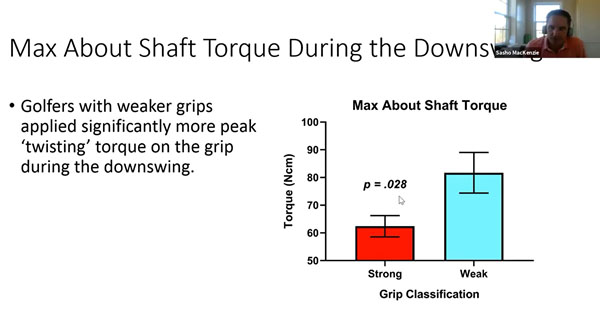
Sasho apparently used the technique of inverse dynamics to calculate the "about-the-shaft" torques produced by the pro golfers and he found that weak trail hand pro golfers applied significantly more "about-the-shaft" torque than strong trail hand grip pro golfers, and the results were statistically significant to a P value of ~0.03.
Sasho also found that the peak speed of the "about-the-shaft" handle twisting phenomenon (in terms of angular velocity) was greater in the weak trail hand grip pro golfers - as seen below.

Here are representative graphs produced by Sasho that shows the timing and magnitude of the "about-the-shaft" torque produced by strong trail hand grip strength pro golfers versus weak trail hand grip strength pro golfers.
Strong trail hand grip strength pro golfer's "about-the-shaft" torque graph

Note that the clubshaft is at the ~P6.5 position, and that a small amount of "about-the-shaft" torque was generated before P6.5 and that a small amount of "about-the-shaft" torque was generated between P6.5 => P7 and that the amount being generated after P6.5 was slightly greater.
Weak trail hand grip strength pro golfer's "about-the-shaft" torque graph

Note that the clubshaft is at the ~P6.5 position.
Note that the "about-the-shaft" torque starts well before P6.5 and that it continues between P6.5 => P7 with most of the torque being generated between P6.5 => P7.
This graph implies that there is "something" about a pro golfer adopting a weak trail hand grip that will lead to the generation of a larger amount of "about-the-shaft" torque, especially in the later downswing between P6.5 => P7.
Let's explore this scenario of "about-the-shaft "torque generation and its resultant counterclockwise club handle twisting phenomenon further by looking at the type of pro golfer - eg. Scottie Scheffler - who would probably fit well into the weak trail hand grip subgroup of pro golfers.
Here are capture images of Scottie Scheffler's late downswing action between P6 => P7.

Image 1 is at P6, image 2 is at P6.5, image 3 is at P6.7 and image 4 is at P7.
Scottie Scheffler uses a weak lead hand grip and a weak trail hand grip.
I have drawn a blue line down the middle of his trail antecubital fossa and a red line along his trail lower forearm's radial bone - note that the red line is rotated clockwise relative to the blue line at P6, P6.5, P6.7 and P7 which means that his trail forearm is continuously supinated during the P6 => P7 time period.
Note that I have drawn a yellow line along his lead lower forearm's radial bone. One cannot see his lead lower forearm's radial bone at P6 because the back of his lead hand and his lead lower forearm's radial bone is parallel to the ball-target line at P6. Note how much his lead lower forearm's radial bone (and the back of his lead hand) is rotating counterclockwise between P6 => P7 mainly due to lead forearm supination. Also, note that his clubface is roughly straight-line-aligned relative to his lead lower forearm's radial bone from an angular rotational perspective between P6.5 => P7 and that his clubface is closing relative to his clubhead path between P6.5 => P7 in direct proportion to the amount of counterclockwise rotation of his lead lower forearm's radial bone that is happening during that same time period.
So, a very basic question arises - could Scottie's lead forearm supinatory action be active between P6 => P7 and therefore be causally responsible for the "about-the-shaft" torque that is being generated between P6 => P7, and which is causully responsible for the clubface-closing phenomenon relative to his clubhead path that is happening between P6 => P7? I believe that Scottie Scheffler, like most pro golfers, is using a pivot-induced lead arm swinging action where the pivot-induced motion of his lead arm is the major casual factor responsible for his swing power generation (maximum clubhead speed at impact) and also for his clubface-closing phenomenon that is happening between P6 => P7.
Consider an example of a skilled golfer performing a pivot-induced lead arm swinging action.
Sasho MacKenzie's lead arm-only driver golf swing action.
Swing video - https://www.youtube.com/watch?v=GgF_9IfROAU
Capture images from the video (images reversed so as to make him appear to be a right-handed golfer)

This video was recorded ~14 years ago when Sasho injured his trail arm and when he temporarily resorted to playing golf with only his lead arm. It is obvious that he is performing a pivot-induced lead arm swinging action and that he must be successfully squaring his clubface relative to his clubhead path during his late downswing's P6 => P7 time period so that he can hit a straight shot. How much "about-the-shaft" torque is Sasho generating between P6 => P7? I strongly suspect that the amount will be inversely proportional to the strength of his lead hand grip. The only rational biomechanical explanation that can explain how he generates that "about-the-shaft" torque profile is that he is performing an active lead forearm supinatory action!
Here is further evidentiary proof that a lead arm-only golfer, who has a professional quality golf swing action, uses an active lead forearm supinatory torque action between ~P5.5 => P7 in order to generate the necessary "about-the-shaft" torque needed to close the clubface relative to the clubhead path by impact.
Consider the following paper written by Sasho MacKenzie - http://www.sashomackenzie.com/publications/MacKenzie%202009%20A%20three%20dimensional%20forward%20dynamics%20model%20of%20the%20golf%20swing.pdf
This what Sasho states in his introductory abstract- : "This paper introduces and evaluates the validity of a 3D six-segment forward dynamics model of a golfer. The model incorporates a flexible club shaft and a variable swing plane. A genetic algorithm was developed to optimise the coordination of the model’s mathematically represented muscles (torque generators) in order to maximise clubhead speed at impact."
Here is an image from his paper showing the angular displacement and the timing/magnitude of torque generation.
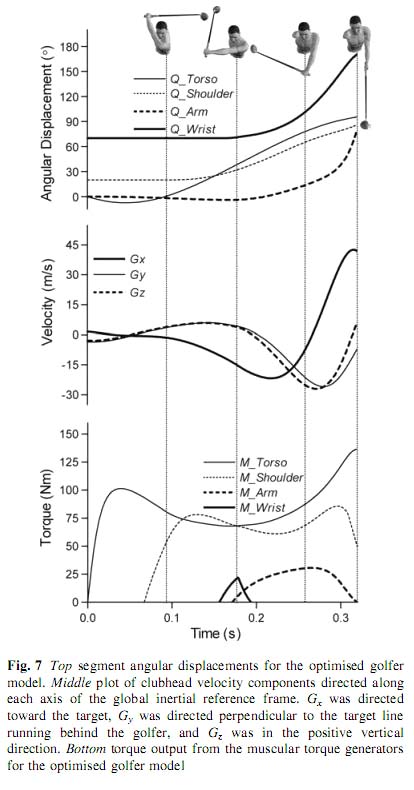
Note that this model golf swing action is a lead arm-only golf swing action, and there is no trail arm.
Note the avatar's position at P5.5 (3rd avatar) and impact (4th avatar) . Note that he is releasing the club (representing the release of PA#2 in TGM terminology) between P5.5 => P7 so that the clubshaft becomes straight-line-aligned with his lead arm at impact. Note that the back of his flat lead wrist/hand is facing the ball-target line at P6 and then facing the target at impact, which means that the back of the lead hand and clubshaft are rotating counterclockwise between P5.5 => P7 (representing the release of PA#3 in TGM terminology).
Look at the Q arm angular displacement graph (dotted line) and note that there is minimal counterclockwise rotation of the lead arm/lead hand/clubshaft happening before P5.5. After P5.5, there is a slow rate of rotation between P5.5 => P6.5 and a faster rate of rotation between P6.5 => P7.
The bottom graph shows the torques needed to produce the angular displacement, and the M Arm torque is the relevant torque that will provide the "about-the-shaft" torque that will twist the club handle in a counterclockwise clubface-closing direction. Note that the M Arm torque generation phenomenon starts before P5.5 and it reaches its peak torque value before ~P6.5 (just before the rapid phase of counterclockwise rotation of the lead arm "about-its-longitudinal axis") and that the M Arm torque measurement starts decreasing a lot between ~P6.5 => P7.
What muscle action (torque generator) is casually responsible for producing that M Arm torque?
Consider this other graph produced by Sasho.
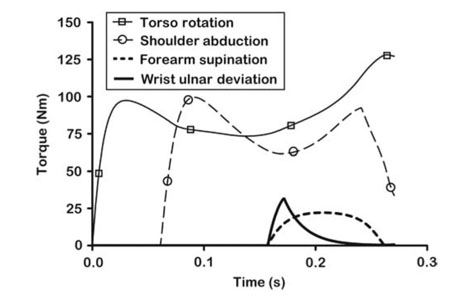
Note that the dotted M Arm torque graph is labelled "forearm supination". That fact suggests that Sasho is implying that the muscular contraction of some of the lead forearm muscles (= torque generator) are casually responsible for the lead forearm supinatory torque needed to provide the necessary amount of lead forearm supinatory motion required to rotate the clubshaft counterclockwise between P5.5 => P7 so that the clubface can be squared relative to the clubhead path by impact. That is exactly what I perceive to he happening in Scott Scheffler's driver golf swing action. If I am correct, then there is no need to conjure up the "idea" that it is actually his trail arm that is causally responsible for the clubface-closing phenomenon relative to his clubhead path that is mainly happening between P6.5 => P7, and which can be clearly seen in the capture images that I have presented.
If a person conjures up the "idea" that it is actually the trail arm/forearm/wrist that is causally responsible for generating the "about-the-shaft" torque needed to square the the clubface relative to the clubhead path between ~P5.5 => P7 - then how would it work from a biomechanical perspective? What biomechanical actions would the trail arm/forearm be doing to generate the needed "about-the-shaft" torque.
The only explanation that I have seen you (Terry) and Mike Adams offer is the "idea" that when the trail arm straightens in the later downswing that the trail forearm will pronate and that the pronatory motion of the trail forearm will provide the needed counterclockwise "about-the-shaft" torque. There is a major problem with that theory and that is the incontrovertible fact that the trail forearm does not normally pronate between P6 => P7 in most pro golfers.
Here is Jon Sinclair's graph of lead and trail forearm rotation happening in the late downswing between P6 => P7 in his collection of >100 PGA tour pro golfers..
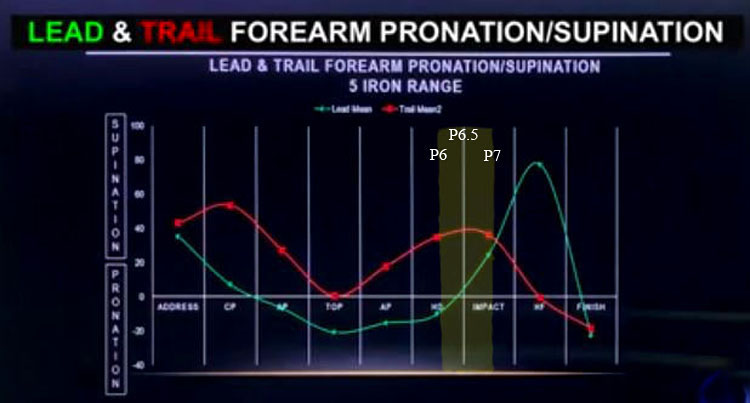
Supination is above the horizontal white line, and pronation is below that line.
The yellow-colored zone represents the P6 => P7 time period.
The red graph is the trail forearm rotation graph and the green graph is the lead forearm rotation graph. Note how much the lead forearm is supinating between P6 => P7 and that lead forearm supinatory motion can theoretically be causally responsible for the clubface-closing phenomenon relative to the clubhead path that is seen in Scottie Scheffler's late downswing. Note that the trail forerarm is actually supinating slightly more between P6 => P6.5, which means that it is rotating in a clockwise (and not a counterclockwise) direction, which means that it cannot be providing the counterclockwise "about the "shaft" torque, or counterclockwise rotary motion needed to rotate both the clubshaft and the clubface counterclockwise between P6 => P6.5. Note that there has been minimal change in the trail forearm's degree of supination between P6.5 => P7 so it cannot be providing the needed "about-the-shaft" torque seen in Sasho's weak trail wrist torque graph during the P6.5 => P7 time period. So, what biomechanical action involving the trail arm/forearm/wrist do you (or Phil Cheetham or Sasho MacKenzie) hypothesise is producing that large amount of "about-the-shaft" torque that reaches its peak magnitude between P6.5 => P7 (according to Sasho's inverse dynamics calculations for a weak trail hand grip strength pro golfer)?
Note that I have bold-highlighted the statement that the "about-the-shaft "torque is increasing after P6.5 and that it reaches its peak torque value just before impact when the clubshaft is simultaneously reaching its peak "about-the-shaft" rotational angular velocity. How is that biomechanically possible? What biomechanical action can the trail arm/forearm/wrist be performing between P6.5 => P7 that will cause the "about-the-shaft" torque and the counterclockwise rotary motion of the clubshaft to simultaneously reach its peak values at approximately the same time just before impact?
I can think of only one possible biomechanical action that could explain how the trail arm/forearm/wrist can produce that "about-the-shaft" torque pattern where the "about-the-shaft" torque peaks after P6.5 and just before impact - and that is where the golfer actively straightens the trail wrist between P6.5 => P7 while simultaneously performing a trail wrist circumductory roll motion in a counterclockwise direction. In that type of golf swing action where the trail arm/wrist/hand are very active during the P6.5 => P7 time period, the trail palm will be working as a positive hand couple in the later downswing just before impact, and where push-pressure is being actively applied by the trail palm against the lead hand's thumb area (which is above the coupling point) and also against the aft side of the club handle just below the coupling point. I frequently see that pattern in amateur golfers who use their trail arm/hand very actively between P5.5 => P7 and who use a very active slap-hinge hand release action through impact that causes the clubshaft to quickly bypass their stalled lead arm very soon after impact.
I wonder whether you are personally using that type of golf swing pattern when you demonstrate in a swing video how you can perform a golf swing action using different trail hand grip strengths (weak-strong-neutral).
Here are capture images from that video of your trail arm/forearm/wrist/hand/clubshaft motions through impact .

Note the pattern of your trail arm/forearm/wrist/hand action through impact when you perform a golf swing action using a weak (on-top) trail hand grip.
Note that you are i) fully straightening your trail elbow and ii) pronating your trail forearm and ii) actively straightening your trail wrist, which leads to your trail palm rolling over your lead hand through impact. You are also not performing an active pivot motion and you are stalling the forward (targetwards) motion of your lead arm at impact. Note how the clubshaft quickly bypasses your lead arm very soon after impact.
I would not be surprised to discover that your "about-the-shaft" torque profile closely matches the pattern seen in Sasho's weak trail hand grip strength graph.
I have never seen a pro golfer who manifests your exact pattern of trail arm/forearm/hand motion through impact - although I have seen countless amateur golfers use that pattern.
One of the closest examples of a pro golfer, who is possibly using an active trail arm/forearm/hand motion pattern through impact, would be Patrick Reed.
Capture images of Patrick Reed's hand release action through impact.
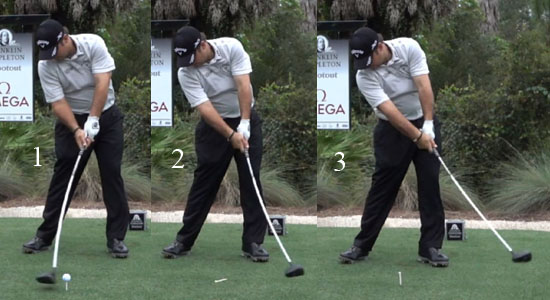
Image 1 is at impact, image 2 is at P7.2 and image 3 is at P7.4.
At impact he still has a i) bent trail arm, ii) a supinated trail forearm, and a slightly extended trail wrist.
However, note what happens between P7 => P7.4 - note that i) his trail arm is fully straightening; ii) his trail forearm is pronating, and ii) his trail wrist is straightening while he is stalling the forward (targetward) motion of his lead arm, and those biomechanical actions conjointly cause his clubshaft to bypass his lead arm (from an angular rotational perspective) during his early followthrough time period.
However, that particular golf swing pattern manifested by Patrick Reed is not a direct casual consequence of adopting a weak trail hand grip, because it is possible to perform a very different golf swing motional pattern and a very different hand release action through impact when adopting a weak trail hand grip.
Consider this example - featuring Patrick Rodgers.
Capture images of Patrick Rodgers at address.
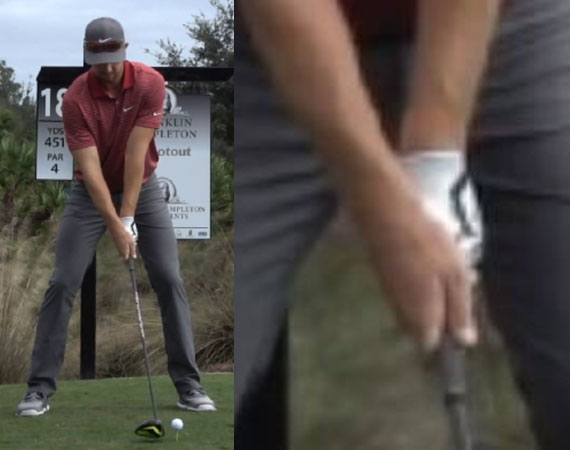
At address (image 1), his trail humerus is internally
rotated to a small degree so that his trail antecubital fossa faces more
towards the target and it does not face the ball-target line. Note that he
has an on-top trail hand grip and a neutral lead hand grip. Note that the
back of his lead hand faces the target at address.
Now, consider his clubface-closing phenomenon seen in his late downswing
between P6.5 => P7.
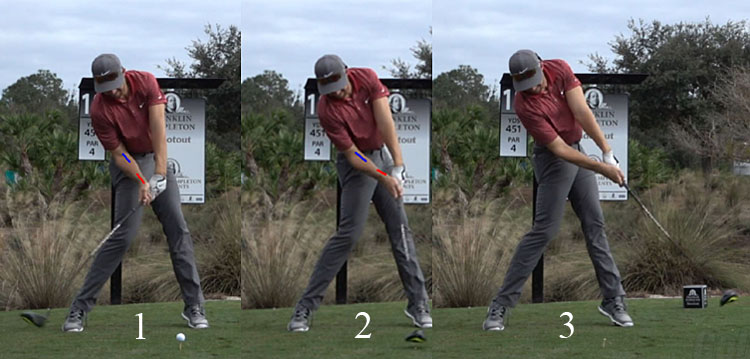
Image 1 is at P6.5, image 2 is at P7 and image 3
is at P7.4.
I have drawn a blue line down the middle of his trail antecubital fossa
and a red line along his trail lower forearm's radial bone.
Image 1 shows that his trail forearm is significantly supinated at P6.5
and that the back of his lead wrist is facing more towards the
ball-target line, which means that very little counterclockwise rotation
of his lead hand happened between P6 => P6.5. Note that his clubface is
still significantly open relative to his clubhead path at P6.5.
Image 2 shows that the back of his lead hand is facing the target at
impact due to a large amount of lead forearm supination that is
happening between P6.5 => P7 - note how much his lead lower forearm's
radial bone has rotated counterclockwise between P6.5 => P7. Note that
there is a direct proportional relationship between the amount of
counterclockwise rotation of the back of his hand happening between P6.5
=> P7 and the amount of counterclockwise rotation of the clubface that
is happening during the same time period - strongly suggesting a
direct causal relationship. Note that very little counterclockwise
rotation of his trail forearm in a pronatory direction is happening
during the same time period, which suggests that the counterclockwise
rotation of his trail forearm cannot be the major causal factor
responsible for the clubface-closing phenomenon of the clubface
(relative to the clubhead path) that is happening between P6.5 => P7.
Look at his trail hand's true palm area (= area just proximal to the
base of his trail hand's 2nd - 5th fingers) at P6.5 and P7 - you will
note that it rotates at the same rotational speed as the back of his
lead hand in a counterclockwise direction. How is that possible if there
is so little counterclockwise rotation of his trail forearm happening
during that P6.5 => P7 time period? I believe that the correct answer is
that his trail wrist is becoming significantly less extended between
P6.5 => P7 and that allows the trail palm to roll in a counterclockwise
direction, especially if a finite degree of counterclockwise trail wrist
circumductory roll motion happens during his trail wrist's partial
straightening action. However, I strongly suspect that his trail wrist's
circumductory roll motion is passive, and not active.
Note that Patrick Rodgers is performing a DH-hand release action between P7 => P7.4 where the clubshaft is not bypassing his lead arm from an angular rotational perspective, and that allows him to more easily keep his clubface square to his clubhead path between P7 => P7.4. He is not using a handle-dragging "hold-off" hand release action where the lead wrist is held fixedly/rigidly in the same degree of lead wrist flexion and he is allowing his lead wrist to extend during the early followthrough time period between P7 => P7.4, but only by a small amount that will not cause the clubshaft to bypass his lead arm (from an angular rotational perspective). Note how he is able to retain a partly bent trail arm and a partly extended trail wrist all the way to P7.4, and that is only biomechanically possible because he does not "run-out-of-trail arm" - due to the fact that he moves his trail shoulder far enough downplane so that the distance between his trail shoulder and his trail hand does not get too large (considering the additional fact that there is a significant amount of targetward motion of his lead hand happening between P7 => P7.4). By maintaining roughly the same degree of bent trail arm and the same degree of extended trail wrist through the impact zone between P7 => P7.2 it potentially allows his hand couple to work as a negative hand couple through impact, which could have a mechanical-stabilising effect on his lead wrist and make it less likely to extend too much in the immediate post-impact time period. Note that to perform a DH-hand release action as efficiently as Patrick Rodgers, that he has to ensure that he rotates both his pelvis and upper torso counterclockwise by a sufficiently large amount between P7 => P7.4 and he also cannot stall the forward (targetwards) motion of his lead arm at impact. Most importantly, note that his use of a weak trail hand grip does not prevent him from performing a DH-hand release action in a very efficient manner.
Although Patrick Rodgers is using a weak trail hand grip (like Patrick Reed) his entire downswing action and his hand release actions through impact is very different in style. He is using a very active pivot motion golf swing style and a pivot motion-induced release of his lead arm. He is seemingly using the standard PA#3 release action, where the clubface-closing phenomen relative to the clubhead path that is happening between P6.5 => P7 is most likely due to lead forearm supination. He is not stalling the forward (targetwards) motion of his lead arm at impact and the forward angular rotational motion of his lead arm perfectly matches the forward angular motion of his clubshaft between P7 => P7.4. He never i) fully straightens his trail arm, or ii) pronates his trail forearm or iii) fully straightens his trail wrist through impact.
I cannot imagine that his "about-the shaft" torque profile will match the pattern seen in Sasho's graph for a weak trail hand grip strength golfer (like Patrick Reed) and I suspect that it will more likely resemble the pattern seen in Sasho's graph from his forward dynamics paper.
I am obviously implying that any significant likely difference between Patrick Reed's and Patrick Rodgers "about-the-shaft" torque pattern has nothing to with the fact that they both use a weak trail hand grip, and much more to do with how actively they perform a pivot action in the downswing and how they biomechanically perform a hand release action through impact. I also wonder whether there was selection bias in Sasho's selection of 19 pro golfers who use a weak trail hand grip and whether he arbitrarily chose pro golfers who perform a golf swing action like Patrick Reed, rather than like Patrick Rodgers.
I also think that lead hand grip strength could be a major confounding variable in this type of research study.
Consider a pro golfer - Matthew Fitzpatrick - who uses a weak trail hand grip combined with a very strong lead hand grip.
Capture images of Matthew Fitzpatrick's late downswing action.

Image 1 is at P6, image 2 is at P6.5, image 3 is at P7 and image 4 is at P7.3.
Note that the back of his lead hand is facing the ball-target line at P6. Note that there has been minimal counterclockwise rotation of his lead hand between P6 => P7 due to lead forearm supination - and that fact is very important if he wants avoid closing his clubface too much before impact. MF has no choice but to reach impact with the back of his lead hand still being roughly parallel to the ball-target line and with the ulnar border of his lead hand facing the target. If he performed too much lead forearm supination, or if he straightened his trail arm fully-and-pronated his trail forearm, between P6 => P7 it would likely close his clubface relative to his clubhead path too much and he would have a closed clubface at impact. So, although he has a weak trail hand grip, I cannot imagine that it will result in a large amount of "about-the-shaft" torque after P6.5 (as seen in Sasho's weak trail wrist strength graph) because that would cause his clubface to close too much by impact.
So, the fundamental question arises as to whether lead hand grip strength (especially a very strong lead hand grip) and/or the pattern of release of PA#3 in a golfer who is using an active pivot-driven lead arm swinging action with a weak-or-neutral lead hand grip, could be major confounding variables that would invalidate the scientific conclusiveness of Sasho's small research study. Do you know whether Sasho took these potential confounding variables into full account and ensured that they could not possibly influence his research study's results in a negative (confounding) manner? Do you know how many golfers in the weak trail wrist strength subgroup also had weak lead wrist grip strengths and how many golfers in the strong trail wrist strength subgroup also had strong lead hand grip strenghts, because a disproportionate amount would bias the study's results?
I think that the most puzzling finding featured in Sasho's research results is his "across-the shaft" torque graph in the weak trail wrist strength golfer where the torque increases after P6.5 and peaks just before impact. I cannot understand how that is biomechanically possible if the trail forearm is not significantly pronating during that time period. I theorised about the biomechanical possibility that during the trail wrist's partial straightening phenomenon that happens between P6.5 => P7 that the trail wrist could be performing an active trail wrist circumductory roll motion in a counterclockwise direction that could possibly generate that increasing "across-the-shaft" torque measurement. However, both Dr Young Hoo Kwon and Sasho have analysed the driver golf swing actions of pro golfers and they have both shown that the trail hand couple torque is negative in the later downswing, and they have both stated that the trail hand can barely keep up with the very fast forward motion of the clubshaft during the P6.5 => P7 time period and that the trail hand cannot possibly be applying a positive push-force during that time period. So, if my theoretical explanation is not valid, then what biomechanical action is the trail arm/forearm/wrist performing that causes the "across-the-shaft" torque to be increasing after P6.5 in weak trail hand grip strength pro golfers? I would very much like to see you (or Phil or Sasho) answer that very pertinent question?
Jeff Mann.